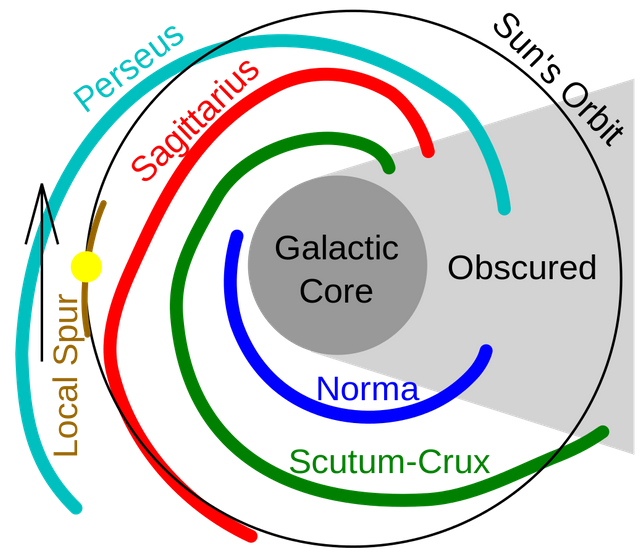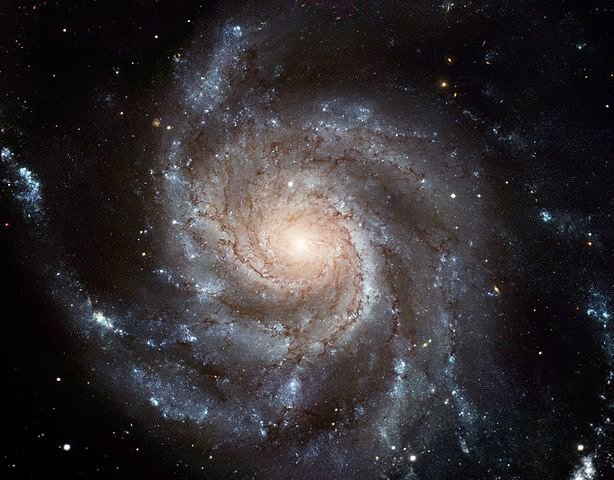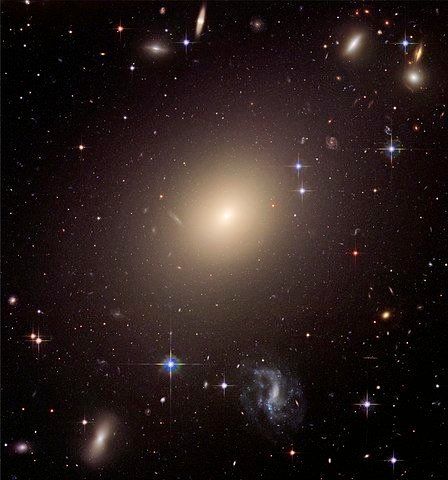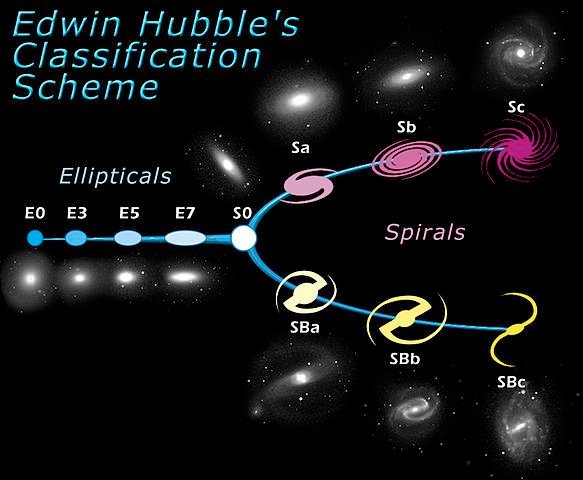COSMOLOGY: The strange darkness, Olbers' Paradox and the main features of the Universe.
With so many stars in the sky, why is it dark at night? This question puzzled astronomers in the seventeenth century and came to be known as Olbers’ paradox, after Heinrich Olbers (Germany, 1758-1840) who posed it.

The Newtonian Universe is infinite in size and contains an infinite number of stars', astronomers thought. ‘So everywhere you look, your line of sight should end on the surface of a star, and the whole night sky should be as bright as the surface of an average star.’ This is clearly not the case. Even the greatest astronomers could find no flaw with the argument, which is why it is called a paradox. The margin gives the argument mathematically.
But Olbers’ paradox is no longer a puzzle. The Universe is still infinite and may well contain an infinite number of stars, but it is no longer a static Newtonian universe. Because of the way it is expanding, light from the very distant stars will never reach us: they are receding so rapidly that the energy of the light they emit is effectively reduced to zero. This conveniently leaves us with darkness at night.
THE MATHEMATICAL EXPLANATION OF OLBERS' PARADOX
Number of stars per unit volume of space = N
Volume of a spherical shell centred on Earth = 4πr2Δr
So number of stars in each shell is proportional to r2. Assume a constant mix of star types, on average; then light emitted from a shell is also proportional to r2.
But light obeys the inverse square law, getting weaker with distance, in proportion to 1/r2. So each shell produces the same intensity of light at the Earth. If there are an infinite number of shells, then the night sky should be infinitely bright! But, the intensity of light from each shell of stars decreases as r increases. But the number of stars in each shell increases as r increases – just enough to compensate.

Now, let's discuss what cosmology is all about..........
THE IDEAS IN THIS ARTICLE
I will start with the meaning of cosmology, which is simply the study of the Universe as a whole. The Universe contains not only the very large – such as the huge groups of stars called galaxies. It also contains the very small particles of matter. I will discuss both in the next paragraph, which deals with the main features of the Universe, its age and size, and links the current theory of the Universe in the hot Big Bang model.
THE MAIN FEATURES OF THE UNIVERSE
BEYOND THE SOLAR SYSTEM
The stars we see with the unaided eye are the nearest stars to earth, at distances ranging from just over 1 parsec (the star Alpha Centauri) to 500 or so parsecs. Remember 1 parsec (PC) = 3.26 light years. We see the Milky Way as a broad, dispersed band of light in the night sky. A pair of binoculars shows that it is composed of a host of faint stars, all very close together in the field of view. There are an estimated hundred billion stars in the Milky Way system. A collection of stars this size is called a galaxy. Plotted in the two dimensions, the stars form the patterns shown in the figure illustrated below.
Most of the stars lie in a narrow disc with a central globular nucleus, now thought to contain a massive black hole. Surrounding the disc is a larger elliptical region, the galactic halo, which contains lone stars at a lower density, and a number of globular star clusters. Each cluster is 2 to 100 pc across, containing about a thousand to a million Sun-sized stars of roughly the same age, packed closely together.

As the figure shows, the stars are arranged in long arms that spiral out from the nucleus, forming a disc 30 kpc in diameter. The Sun is a star of slightly below average size on the edge of a spiral arm, about two-thirds of the way out from the galactic centre.
Constellations are the patterns of stars we see in the sky with the unaided eye. These stars are usually far apart, some being much further away than others, the line of sight giving an illusion that are somehow connected together. But most stars are in fact quite close together: in pairs, small group (like the 'Seven Sisters' or Pleiades) or large stellar clusters. Stars in the more open galaxies like the Milky Way are about 5 light-years (15 kpc) apart, on average. Galaxies are of course much further apart: in our local cluster, they range from a few hundred kiloparsecs to a megaparsec or so.
BEYOND THE MILKY WAY
Early astronomers discovered many bright objects larger than stars and looking like clouds of bright gas and dust, so they were called nebulae after the Latin for 'clouds'.
Charles Messier (France, 1730-1817) first drew up a list of nebulae, stellar clusters and galaxies, which was published as the <i>Messier Catalogue</i>. Most of the bright nebulae in the northern half of the sky are still labelled by Messier numbers. For example, the Andromeda Galaxy is Messier 31, or M31 for short. In another system, the <i>New General Catalogue</i> of nebulae, galaxies and clusters, the letters NGC prefix the number.
Later, astronomers found that many of these nebulae were not clouds of gas but collections of very many billions of stars, very much further away than the ordinary stars in the Milky Way. They were called extra-galactic objects.
CLASSES OF GALAXIES
Galaxies fall into three main classes. They are:
- Spiral galaxies, rather like the Milky Way
- Elliptical galaxies, with no apparent structure
- Irregular galaxies, with no definite shape or structure.
SPIRAL GALAXIES
A spiral galaxy is typically 30 kpc in diameter. Typically, it is a bright object in the sky, with many young hot stars in the arms, and with about 1011 stars producing a total luminosity 1010 times that of the Sun. It spins about its centre of mass.

The spectra of the stars in the arms show that they contain heavy elements (metals) which can only have been made in a supernova explosion, so these stars are recycling material that has formed at least one star already. A spiral galaxy also contains a lot of hydrogen as interstellar gas at a density of about six atoms per cubic metre of space between stars.
It was detected that the gas from the radio waves it emits was at a wavelength of 21 cm. Astronomers have worked out the positions of the spiral arms in our galaxy by plotting the Doppler change to this wavelength caused by their rotation.
The separate arms of a spiral galaxy are assumed to have been caused by huge compressive waves passing through the cloud of gas and dust from which the galaxy was formed. These waves compress the cloud and trigger the gravitational collapse that eventually leads to star formation.
ELLIPTICAL GALAXIES
Elliptical galaxies contain mostly old stars. They are not very bright and rarely contain traces of heavy elements (metals). On average, they are smaller than spiral galaxies, at 10 kpc or so, and much less luminous, at about 108 solar luminosity. Elliptical galaxies have little gas and dust, so it is likely that star formation has ceased.

IRREGULAR GALAXIES
Irregular galaxies are smaller than the first two classes, at an average size of
7 kpc. They have a mass of about 108 solar masses but at 109 solar luminosities. They are quite bright for their mass. They contain young, metal-poor stars but are rich in gas and dust, so they have regions of active star formation.
ACTIVE GALAXIES AND QUASARS
Amongst these various types of galaxy are active galaxies. Active galaxies have compact energetic nuclei, small (by comparison) regions, which emit radiation strongly with an intensity at least as great as that from a whole ordinary galaxy. The most likely explanation is that the nuclei contain a supermassive black hole, with masses 106 to 1010 solar masses. The black hole draws in surrounding material whose destruction gives rise to the energy output. It is now thought that, in general, galactic nuclei, of the kind we have at the centre of our Milky Way, also contain a smaller but still massive black hole.
Radio galaxies are also active galaxies, and cover huge areas of the sky, centred on a smaller galaxy (usually an elliptic one). The radio waves come from jets of ionised material ejected at high speed from the galactic nucleus: again, the energy seems to come from gravitational collapse, with a supermassive black hole the likely culprit.
Quasars are small, compact extremely bright objects, which emit as much as a 1000 times the energy that comes from a galaxy such as the Milky Way. Quasar stands for ‘quasi-stellar’ object because they are nearer in size to stars than to galaxies: they are considered now to be ‘naked’ galactic nuclei. They were first discovered as intense radio ‘stars’. The most likely energy source is the same as that for active galaxies, but they produce much more energy. Because they are so bright, they are the furthest objects we can see and obtain redshifts for.
MEASURING THE DISTANCES TO GALAXIES
The distances to the nearest stars can be found by triangulation – the method of parallax which I've described in one of my previous articles. But extra-galactic objects such as galaxies are too far away to show parallax. Some of the other methods used will be discussed in the next paragraph.
DISTANCE, BRIGHTNESS AND CEPHEID VARIABLES
Edwin Hubble (USA, 1889-1953) was the first astronomer to study galaxies and their distances in detail. This work, begun in 1924, used the 2.5 m diameter Newtonian reflector at Mount Wilson in California – the largest telescope in the world at the time.
He also used a very good method for measuring the distances to galaxies based on an odd kind of star called a cepheid variable, or cepheid for short, named after Delta Cephei in the constellation Cepheus, the first such star discovered.

These stars vary in their brightness very regularly over time. The astronomer Henrietta Leavitt (USA, 1868-1921) had found many cepheids in the irregular galaxies called the Magellanic Clouds and was able to show that the period of the variation is related to the star’s intrinsic brightness i.e its absolute magnitude. Once the distance of a typical nearby cepheid had been found it was possible to calibrate the variation graphs. This allowed a simple calculation of a star’s absolute brightness and hence its distance using the relationship between absolute (M) and apparent magnitude (m) and distance (D) in parsecs i.e:
M = m + 5 - 5 log D
Hubble used data about cepheids found in the Andromeda Galaxy M31 to calculate its distance and confirmed that this was an extra-galactic object. (In 1923 it had been the first galaxy to have its distance estimated, at 450 kpc, using an assumption about its luminosity.)
Unfortunately for Hubble, there are two kinds of cepheid star, and not knowing this at the time he used data for the wrong kind, so his measured distances for galaxies containing cepheids were all too low. For example, for M31 he obtained a distance of 330 kpc. It was later found to be 770 kpc.
Cepheids are brighter than the Sun, but even so, when they are too far away they get too faint to be useful for calculating differences. Recently the Hubble Space Telescope has extended the range from about 6 Mpc to about 17 Mpc.
USING VERY BRIGHT OBJECTS
The same magnitude-distance formula can be used to measure distances further out, using very bright stars of known luminosity, such as supergiant stars to 10 Mpc, and even supernovas (to 200 Mpc). The same method can be used to 1200 Mpc by assuming that the brightest galaxies all have much the same size and so have similar luminosity.
REDSHIFT
As the Universe is expanding light from distant objects shows a Doppler effect causing a shift of spectral lines to the red (long wavelength) end of the electromagnetic spectrum, and this can be used to measure very large distances.
In the next post, I'll be discussing the clusters and superclusters of galaxies, the expanding universe and other interesting subjects of cosmology.
Till then, I remain my humble self, @emperorhassy.
As usual, a very nicely written post! Thanks for contributing to SteemSTEM! I have a couple of comments :)
Actually, there is no way to prove this. In standard cosmology, we consider what we call the observable universe that has a finite size. There is no way to know what lies beyond this. It could be something or nothing.
Or the famous M87 and its famous black hole :)
Thanks, @lemouth for the good compliment and also for the great couple of comments.
You are very welcome my friend!
Congratulations @emperorhassy! You have completed the following achievement on the Steem blockchain and have been rewarded with new badge(s) :
You can view your badges on your Steem Board and compare to others on the Steem Ranking
If you no longer want to receive notifications, reply to this comment with the word
STOPTo support your work, I also upvoted your post!
This post has been voted on by the SteemSTEM curation team and voting trail. It is elligible for support from @curie and @utopian-io.
If you appreciate the work we are doing, then consider supporting our witness stem.witness. Additional witness support to the curie witness and utopian-io witness would be appreciated as well.
For additional information please join us on the SteemSTEM discord and to get to know the rest of the community!
Thanks for having added @steemstem as a beneficiary to your post. This granted you a stronger support from SteemSTEM.
Thanks for having used the steemstem.io app. You got a stronger support!
Hi @emperorhassy!
Your post was upvoted by Utopian.io in cooperation with @steemstem - supporting knowledge, innovation and technological advancement on the Steem Blockchain.
Contribute to Open Source with utopian.io
Learn how to contribute on our website and join the new open source economy.
Want to chat? Join the Utopian Community on Discord https://discord.gg/h52nFrV
Excellent article, the first few paragraphs really work at capturing the reader's attention, and even though you then explain more complex aspects of cosmology, you do it in a way that is easy to understand for the general public.
I don't know what I always though that the stars in constellations were close to each other, in a straight line even. After reading this, the reality seems so obvious. By the way, I always thought that parsecs were made up for Star Wars, I assume that they are not used correctly in that media..? ("I made the Kessel run in 12 parsecs...")
Posted using Partiko Android
That's it. @lemouth just answered your question perfectly.
Thanks for coming by, @mike961.